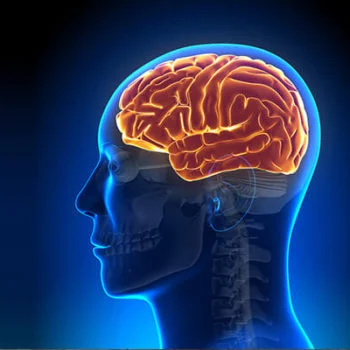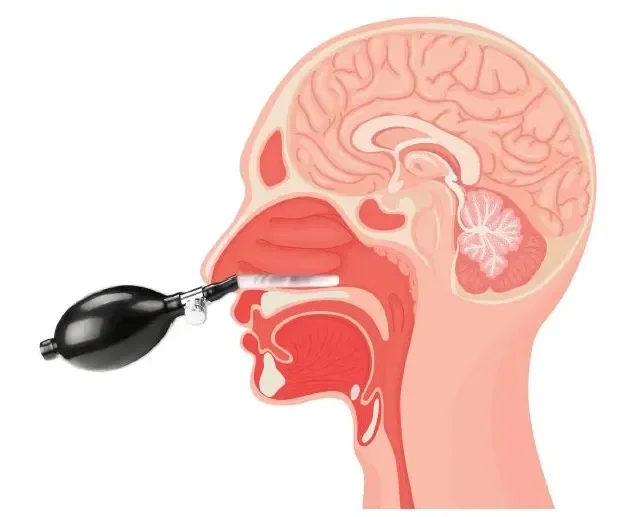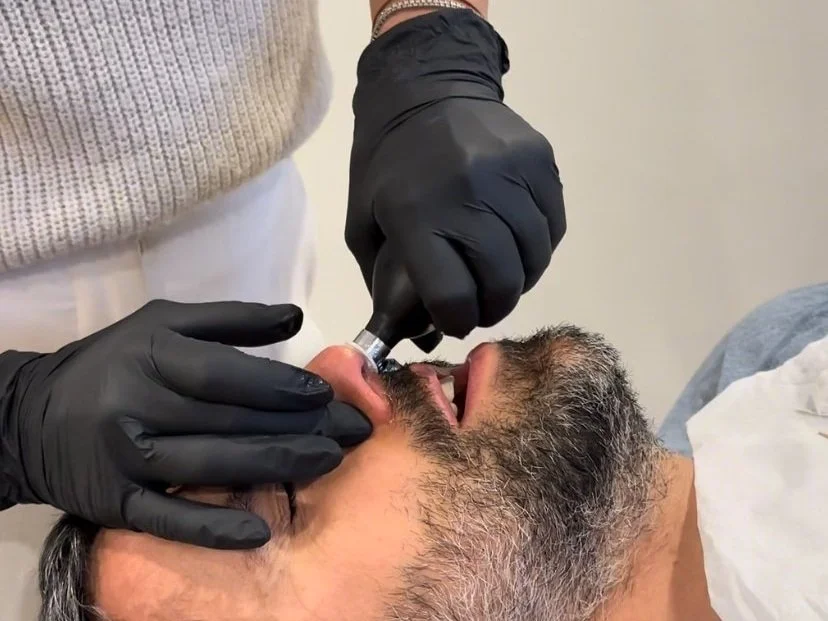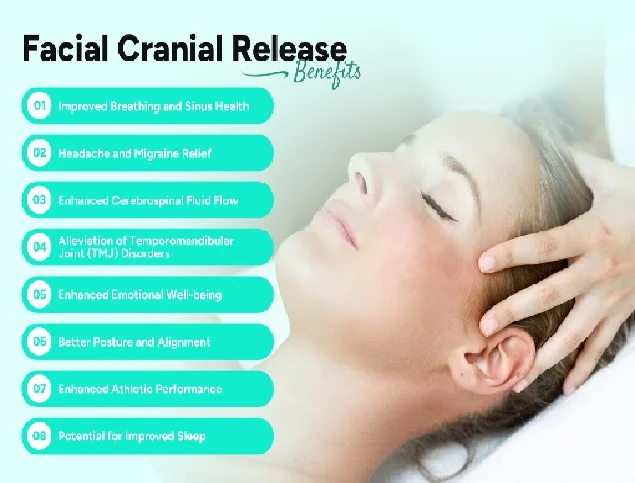Cranial Facial Release (CFR) is an advanced chiropractic technique that focuses on adjusting the bones of the face and skull. Specifically, it targets the mobility of the cranial system, aiming to treat various structural and neurological conditions. This procedure is relatively new but has gained attention due to its effectiveness in addressing ailments that don’t respond well to conventional treatments.
Let’s dive into what cranial facial release is, how it works, its benefits, and any potential side effects.
What Is Cranial Facial Release?
Cranial Facial Release (CFR) is an endo-nasal procedure designed to improve cranial respiratory function by mobilizing the bones in the face and cranium. It involves the insertion of tiny balloons into the nose (the nasopharynx) that are quickly inflated to induce movement in the bones, particularly the sphenoid bone.
This technique was developed by Dr. Adam Del Torto, DC, as an extension of Bilateral Nasal Specific (BNS), a similar procedure pioneered in the 1960s by chiropractor Richard Stober. While CFR is based on BNS, it’s known for being more precise and less invasive.
How Does Cranial Facial Release Work?
To understand how cranial facial release works, it’s important to know that the skull isn’t just one solid bone. Instead, it consists of 22 individual bones that move slightly every time you breathe. These movements help maintain normal cranial function and, in turn, proper brain function.
Cranial fixations, or restrictions in movement between these bones, can occur due to various reasons like head trauma, birth trauma, or conditions like temporomandibular joint (TMJ) disorder. When these bones can’t move as they should, the body’s neurological and structural balance is disrupted, which may lead to chronic pain or other health issues.
Cranial facial release uses a quick inflation of the balloons to unlock these cranial fixations, restoring the proper movement of the bones. This improved movement enhances cerebral spinal fluid (CSF) circulation throughout the brain and spinal cord, a crucial aspect of normal brain function.

The Importance of Cranial and Sacral Motion
One of the core principles of CFR is the relationship between cranial respiratory motion and sacral respiratory motion. These two motions work together to help circulate cerebrospinal fluid. The fluid is produced in the choroid plexus and flows through the brain and spinal cord, playing a key role in maintaining neurological health. Any disruption to this fluid flow, due to cranial fixations, can affect brain function and overall body health.
Benefits of Cranial Facial Release
Many people opt for cranial facial release as a treatment after they’ve exhausted other options. This non-invasive procedure offers several benefits:
- Improved Cranial Function: By addressing cranial fixations, CFR helps improve the movement of cranial bones, which can enhance brain and nervous system function.
- Pain Relief: Many patients with chronic headaches, TMJ disorder, and sinus issues report relief after undergoing CFR treatments.
- Enhanced Respiratory Function: Since the procedure targets the sphenoid bone, which plays a critical role in cranial respiratory motion, CFR can improve overall respiratory function.
- Non-Invasive: Unlike surgeries or long-term medication use, CFR provides relief without invasive methods.
- Cost-Effective: CFR is a cost-effective alternative to expensive tests, treatments, and surgeries. You won’t need to spend a fortune on diagnostics or prescriptions.
How Is Cranial Facial Release Performed?
During a cranial facial release session, small balloons are inserted into the patient’s nose, specifically in the nasopharynx area. The face and skull bones are moved by rapidly inflating these balloons. The procedure only lasts a few seconds and may be repeated over several sessions (typically four) spread over a week or so.
Many describe the sensation of the balloon inflation as similar to the feeling you get when water shoots up your nose while swimming—not painful, but not the most comfortable either.
Conditions Treated by Cranial Facial Release
Cranial facial release has been successfully used to treat a wide range of conditions, including:
- Chronic headaches and migraines
- TMJ (temporomandibular joint) dysfunction
- Sinus problems
- Post-concussion symptoms
- Neurological disorders
- Breathing issues related to cranial dysfunction
It’s particularly effective for individuals who haven’t found relief from more traditional chiropractic adjustments or other medical treatments.
The Connection Between CFR and Endocrine Health
One unique aspect of CFR is its impact on the endocrine system. The procedure helps relieve dural torque, which in turn reduces mechanical tension on the pituitary gland. This is significant because the pituitary gland, located on top of the sphenoid bone, plays a crucial role in regulating hormones throughout the body.
By reducing pressure on the pituitary, cranial facial release may help normalize hormone function and improve overall endocrine health. This can be beneficial for those suffering from hormone-related disorders.
What Differentiates Cranial Facial Release from Other Techniques?
Cranial facial release differs from other endo-nasal techniques in several ways:
- SOT Protocols: CFR is based on Sacro Occipital Technique (SOT) principles, which means practitioners focus on addressing issues in the spine and dura mater before adjusting the cranium.
- Less Invasive: While some cranial adjusting techniques involve more aggressive manipulation, CFR uses a gentler approach with the balloon inflation method.
- Targeted Adjustment: CFR specifically targets the sphenoid bone, which is a key player in cranial and overall body function.

Should You Try Cranial Facial Release?
If you’ve been struggling with chronic pain, sinus issues, or neurological conditions that haven’t responded to other treatments, cranial facial release may be worth considering. It’s a non-invasive, drug-free option that can offer relief with minimal side effects.
However, as with any medical procedure, it’s important to consult with a licensed chiropractor who is experienced in CFR to ensure it’s the right option for your condition.
Cranial Facial Release: A Complete Guide to the Process, Benefits, and Effects
Cranial Facial Release (CFR) is a specialized chiropractic technique that aims to correct cranial imbalances by adjusting the bones of the face and skull. This method is designed to treat a range of structural and neurological issues, providing relief from conditions that conventional treatments may fail to address. If you’re looking for a non-invasive solution to ailments like sinus issues, migraines, or even neurological disorders, CFR might be the answer you’ve been searching for.
In this article, we’ll break down the process of cranial facial release, its benefits, and potential side effects, so you can make an informed decision.
The Procedure: What to Expect
The cranial facial release procedure is straightforward and quick. During each session, the practitioner inserts small balloons into your nasal passageways. When inflated, these balloons create a sensation similar to getting water up your nose. Although some discomfort is normal, it only lasts for a few seconds. Typically, CFR treatment involves four sessions spread out over seven to ten days.
Conditions Treated by Cranial Facial Release
Cranial facial release has been found to be effective in treating a variety of health conditions. Some of the most common include:
- Breathing disorders
- Sinusitis
- Snoring
- Sleep apnea
- Deviated nasal septum
- Migraines
- Vertigo
- TMJ (temporomandibular joint) disorder
- Facial pain (Trigeminal Neuralgia)
- Facial paralysis (Bell’s palsy)
- Post-Concussion Syndrome
- Seizures
- Neurological disorders
CFR has also proven effective for infants with skull deformities and children with learning difficulties, making it a versatile treatment option.
Side Effects of Cranial Facial Release
Like any treatment, you may be concerned about potential side effects. Fortunately, cranial facial release is a safe, non-invasive technique with minimal risks. The most common side effects include temporary nasal discomfort or mild headaches following the procedure. Usually, these symptoms go away in a few hours.
It’s crucial to have CFR performed by a licensed chiropractor to ensure the procedure is done safely and effectively. If you have any pre-existing conditions like a bleeding disorder or are on long-term medication, consult your chiropractor before undergoing CFR.

CFR and Neurological Health
One of the most exciting aspects of cranial facial release is its impact on neurological health. CFR targets mechanical fixations that can place stress on the pituitary gland, which is located on top of the sphenoid bone. By relieving this pressure, CFR enhances both brain function and hormone regulation, optimizing overall health.
Research dating back to the 1930s by Dr. A.D. Speransky supports the idea that slight mechanical torque on the brain’s control centers can lead to widespread bodily dysfunction. His studies identified over 80 specific disorders linked to cranial torque, lending scientific support to the benefits of CFR.
A Brief History of Cranial Facial Release
Cranial facial release has evolved from early chiropractic techniques like Bilateral Nasal Specific (BNS), developed by Dr. Richard Stober in the 1960s. Dr. Stober had great success using BNS to treat patients with Down’s syndrome, learning disabilities, and other cognitive challenges. His method was particularly effective in children, helping improve their mental and physical abilities.
Today, Dr. Adam Del Torto has modernized this technique, making it more accessible and widely recognized. CFR gained significant attention after it was featured on television, leading to increased global interest from both doctors and patients alike.
Is Cranial Facial Release Right for You?
If you’ve been struggling with chronic conditions like sinus problems, migraines, or neurological disorders and haven’t found relief through conventional treatments, cranial facial release could be an excellent alternative. It offers a safe, non-invasive solution to various ailments and provides quick results with minimal side effects.
Conclusion
Cranial facial release is an innovative and effective chiropractic treatment that has helped countless individuals find relief from chronic pain, respiratory issues, and neurological conditions. Its non-invasive nature, quick results, and wide-ranging benefits make it a compelling option for those seeking alternative treatments. If you’re considering CFR, consult with a licensed chiropractor to discuss whether this procedure is right for you.
FAQs
1. What is Cranial Facial Release (CFR)?
Cranial Facial Release is a specialized chiropractic technique designed to open up the cranial sutures (joints in the skull) and improve the flow of cerebrospinal fluid. The procedure is commonly used to address structural imbalances in the skull, face, and airway.
2. How does CFR work?
CFR involves the use of small balloons that are inserted into the nasal passages and gently inflated. This process creates an opening in the cranial sutures, relieving pressure, improving alignment, and enhancing overall cranial function.
3. What conditions can CFR treat?
CFR is often used for a variety of issues, including:
- Chronic sinusitis
- Sleep apnea
- TMJ (temporomandibular joint) disorders
- Migraines and chronic headaches
- Deviated septum
- Breathing difficulties
- Post-concussion syndrome
- Facial asymmetry
4. Is CFR painful?
Patients may experience temporary discomfort or a feeling of pressure during the balloon inflation. However, the process is brief, and most individuals tolerate it well.
5. How long does the procedure take?
Each CFR session typically takes about 5 to 10 minutes. However, multiple sessions may be required depending on the patient’s condition and treatment goals.
For getting more information Thezvideo.




